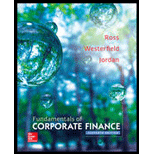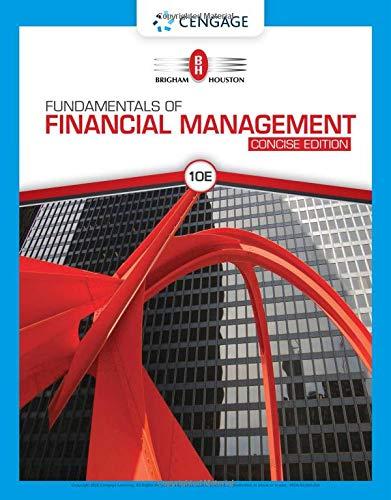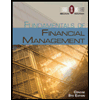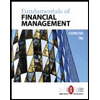
Fundamentals of Corporate Finance
11th Edition
ISBN: 9780077861704
Author: Stephen A. Ross Franco Modigliani Professor of Financial Economics Professor, Randolph W Westerfield Robert R. Dockson Deans Chair in Bus. Admin., Bradford D Jordan Professor
Publisher: McGraw-Hill Education
expand_more
expand_more
format_list_bulleted
Concept explainers
Question
Chapter 17, Problem 6QP
Summary Introduction
To determine: Changes in the equity of the firm due to repurchase of dividends.
Introduction:
Stock repurchase: A company buying its own stock is termed as stock repurchase. It is like the buyback of shares, whereas the cash dividend is the distribution of a portion of company’s earnings to the shareholders.
Summary Introduction
To determine: The new outstanding share.
Summary Introduction
To determine: The price per share after the share repurchase.
Summary Introduction
To discuss: Whether the share repurchase is as effective as a cash dividend.
Expert Solution & Answer
Want to see the full answer?
Check out a sample textbook solution
Students have asked these similar questions
Question:
A company has issued a bond with a face value of $1,000, a coupon rate of 5%, and a maturity of 10 years. If the bond is currently trading at $950, what is the bondholder's yield to maturity (YTM), and how does it differ from the coupon rate? need help!!
A company has issued a bond with a face value of $1,000, a coupon rate of 5%, and a maturity of 10 years. If the bond is currently trading at $950, what is the bondholder's yield to maturity (YTM), and how does it differ from the coupon rate?
What is the time value of money, and why is it important in financial decision-making? Need help!
Chapter 17 Solutions
Fundamentals of Corporate Finance
Ch. 17.1 - Prob. 17.1ACQCh. 17.1 - What are the mechanics of the cash dividend...Ch. 17.1 - How should the price of a stock change when it...Ch. 17.2 - How can an investor create a homemade dividend?Ch. 17.2 - Prob. 17.2BCQCh. 17.3 - Prob. 17.3ACQCh. 17.3 - Why do flotation costs favor a low payout?Ch. 17.4 - Why might some individual investors favor a high...Ch. 17.4 - Prob. 17.4BCQCh. 17.5 - How does the market react to unexpected dividend...
Ch. 17.5 - Prob. 17.5BCQCh. 17.6 - Prob. 17.6ACQCh. 17.6 - Prob. 17.6BCQCh. 17.8 - Prob. 17.8ACQCh. 17.8 - How does the accounting treatment of a stock split...Ch. 17 - Dividends are paid to the parties listed as...Ch. 17 - Prob. 17.3CTFCh. 17 - Prob. 17.4CTFCh. 17 - Prob. 17.8CTFCh. 17 - Dividend Policy Irrelevance [LO2] How is it...Ch. 17 - Prob. 2CRCTCh. 17 - Prob. 3CRCTCh. 17 - Prob. 4CRCTCh. 17 - Prob. 5CRCTCh. 17 - Prob. 6CRCTCh. 17 - Prob. 7CRCTCh. 17 - Prob. 8CRCTCh. 17 - Prob. 9CRCTCh. 17 - Prob. 10CRCTCh. 17 - Prob. 1QPCh. 17 - Prob. 2QPCh. 17 - Prob. 3QPCh. 17 - Prob. 4QPCh. 17 - Regular Dividends [LO1] The balance sheet for...Ch. 17 - Prob. 6QPCh. 17 - Prob. 7QPCh. 17 - Stock Dividends [LO3] The company with the common...Ch. 17 - Stock Splits [LO3] In the previous problem,...Ch. 17 - Homemade Dividends [LO2] You own 1,000 shares of...Ch. 17 - Prob. 11QPCh. 17 - Stock Repurchase [LO4] Galles Corporation is...Ch. 17 - Expected Return, Dividends, and Taxes [LO2] The...Ch. 17 - Dividends and Taxes [LO2] As discussed in the...Ch. 17 - Prob. 15QPCh. 17 - Dividends versus Reinvestment [LO2] After...Ch. 17 - Prob. 1MCh. 17 - Prob. 2MCh. 17 - Prob. 3MCh. 17 - Prob. 4MCh. 17 - Prob. 5MCh. 17 - Prob. 6M
Knowledge Booster
Learn more about
Need a deep-dive on the concept behind this application? Look no further. Learn more about this topic, finance and related others by exploring similar questions and additional content below.Similar questions
- What is the time value of money, and why is it important in financial decision-making?arrow_forwardPlease don't use chatgpt. The formula for calculating the present value of a future amount is:A) Future Value × (1 + r)^nB) Future Value ÷ (1 + r)^nC) Future Value × (1 - r)^nD) Future Value ÷ (1 - r)^n help in this question.arrow_forwardThe formula for calculating the present value of a future amount is:A) Future Value × (1 + r)^nB) Future Value ÷ (1 + r)^nC) Future Value × (1 - r)^nD) Future Value ÷ (1 - r)^n need help!arrow_forward
- no ai What is the primary purpose of diversification in investing?A) To maximize returnsB) To eliminate all riskC) To reduce unsystematic riskD) To ensure stable dividendsarrow_forwardno chatgpt Which of the following is a capital structure decision?A) Deciding how much to pay in dividendsB) Deciding how to allocate funds to various projectsC) Deciding the mix of debt and equity financingD) Deciding how much inventory to purchase need help!arrow_forwardWhich of the following is a capital structure decision?A) Deciding how much to pay in dividendsB) Deciding how to allocate funds to various projectsC) Deciding the mix of debt and equity financingD) Deciding how much inventory to purchasearrow_forward
- No chatgpt!! The weighted average cost of capital (WACC) is used to:A) Measure the profitability of a companyB) Determine the cost of debt financing onlyC) Calculate the company’s average cost of financing from debt and equityD) Estimate the future stock price need help.arrow_forwardNo AI The weighted average cost of capital (WACC) is used to:A) Measure the profitability of a companyB) Determine the cost of debt financing onlyC) Calculate the company’s average cost of financing from debt and equityD) Estimate the future stock pricearrow_forwardCost of Trade Credit A large retailer obtains merchandise under the credit terms of 3/20, net 35, but routinely takes 65 days to pay its bills. (Because the retailer is an important customer, suppliers allow the firm to stretch its credit terms.) What is the retailer's effective cost of trade credit? Assume a 365-day year. Do not round intermediate calculations. Round your answer to two decimal places. The answer is not 27.09 which is incorrect.arrow_forward
- You invest $1,000 a year for 10 years at 6 percent and then invest $2,000 a year for an additional 10 years at 6 percent. How much will you have accumulated at the end of the 20 years? Answer: $49,967 *Please include all work & formulasarrow_forwardNo ai please! What is the role of an underwriter in an IPO?A) To lend money to the companyB) To set the dividend policyC) To buy the securities and sell them to the publicD) To manage the company’s operations need hearrow_forwardNo ai tool What is the role of an underwriter in an IPO?A) To lend money to the companyB) To set the dividend policyC) To buy the securities and sell them to the publicD) To manage the company’s operationsarrow_forward
arrow_back_ios
SEE MORE QUESTIONS
arrow_forward_ios
Recommended textbooks for you
 Fundamentals Of Financial Management, Concise Edi...FinanceISBN:9781337902571Author:Eugene F. Brigham, Joel F. HoustonPublisher:Cengage Learning
Fundamentals Of Financial Management, Concise Edi...FinanceISBN:9781337902571Author:Eugene F. Brigham, Joel F. HoustonPublisher:Cengage Learning Fundamentals of Financial Management, Concise Edi...FinanceISBN:9781285065137Author:Eugene F. Brigham, Joel F. HoustonPublisher:Cengage Learning
Fundamentals of Financial Management, Concise Edi...FinanceISBN:9781285065137Author:Eugene F. Brigham, Joel F. HoustonPublisher:Cengage Learning Fundamentals of Financial Management, Concise Edi...FinanceISBN:9781305635937Author:Eugene F. Brigham, Joel F. HoustonPublisher:Cengage Learning
Fundamentals of Financial Management, Concise Edi...FinanceISBN:9781305635937Author:Eugene F. Brigham, Joel F. HoustonPublisher:Cengage Learning

Fundamentals Of Financial Management, Concise Edi...
Finance
ISBN:9781337902571
Author:Eugene F. Brigham, Joel F. Houston
Publisher:Cengage Learning

Fundamentals of Financial Management, Concise Edi...
Finance
ISBN:9781285065137
Author:Eugene F. Brigham, Joel F. Houston
Publisher:Cengage Learning

Fundamentals of Financial Management, Concise Edi...
Finance
ISBN:9781305635937
Author:Eugene F. Brigham, Joel F. Houston
Publisher:Cengage Learning